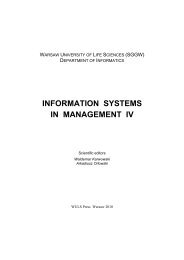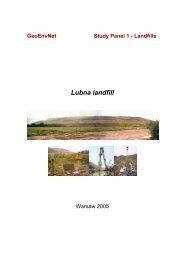ACTA SCIENTIARUM POLONORUM - SGGW
ACTA SCIENTIARUM POLONORUM - SGGW
ACTA SCIENTIARUM POLONORUM - SGGW
You also want an ePaper? Increase the reach of your titles
YUMPU automatically turns print PDFs into web optimized ePapers that Google loves.
132 J. Wiśniewskaemployed in agriculture and a return on the invested capital. Similarly, such understandingof the notion of parity has found its reflection in legal acts in the USA, Great Britainand Germany in the 1950s and 1960s. The definition of parity is broadly discussed inPolish economic and agricultural encyclopaedias. It is described in the section devotedto the profitability of agriculture. It appears as an explanation of the term ‘income parity’,as a situation of equal incomes of comparable farming and non-farming populations [Woś1998]. Further encyclopaedias include the term ‘income disparity’ and explain it as thedifference between the incomes per person employed in agriculture and the income perperson employed in other, non-agricultural professions [Encyklopedia... 1984]. Parity inagriculture can be considered in a number of aspects. The very claim of a parity indicatesthat it is a given part of the national economy that is in question. The hitherto researchmost often includes studies of income disparity between agriculture and non-agriculturalpart of the economy (exogenous parities) and, less frequently, those concerning the differentiationof incomes in agriculture (endogenous parities).The present state of knowledge and the scientific research have not succeeded in unifyingthe parity ratio methodologically, i.e. they have not defined the kinds of incomes tobe taken into account in comparisons. Allowing for quantitative and qualitative aspectsof the labour factor in agriculture and non-agricultural employment, creating a givencharacter of the labour market is indispensable in comparative research. Defining theprofessional groups whose incomes are to be compared with farmers – either, as onegroup of economists suggests, workers – or the self-employed in non-farming industries,as others claim. Also, it needs to be clarified whether the incomes to be compared are tobe incomes from all possible sources or from one kind of employment only. Comparingand studying incomes results in defining the level of social justice (income justice) andeconomic efficiency of production. Justice is associated with a low risk of poverty threatwhile efficiency is linked with a high motivation to work and efficiency.The concept of disparity in farmers’ incomes in relation to non-farming populationis directly connected with the agrarian issue in economic policy. The agrarian issue isconsidered in the context of a rule of law and the political system, according to whichall professional and social layers of the population are equal. The income policy thusassumes that the incomes in farming and outside farming should show the same rate ofgrowth in incomes. The egalitarian tendencies connected with the rule of social justicetogether create certain expectations of farmers towards the state. There is an increasingpressure of the farming lobby on equalising the incomes not only by means of a propereconomic policy, but also by means of a proper social policy [Idczak 2001].The notions of parity and disparity are the two notions commonly used by economiststo evaluate income levels. They function in economic sciences as normative termsdescribing the situation of some selected economic categories being equal or being different.At the same time, Polish economic dictionaries define the term ‘parity’ as theone which only concerns monetary values in monetary and currency systems and thepurchasing power of money. International dictionaries define the notion of ‘parity’ similarly,not using the concepts of income parity or disparity. The causes of disparities inagriculture differ from the conditions of income division in non-agricultural parts ofthe national economy. Despite the common economic features, there are some specialcircumstances, typical for the agricultural economy, such as the inflexibility of demandActa Sci. Pol.
















